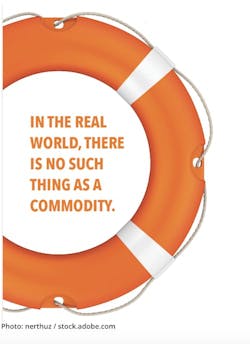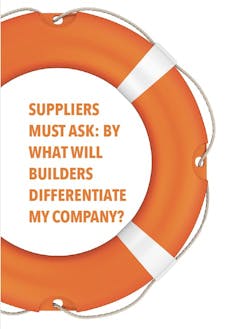Supplier Survival: Adopt a Highly Differentiating Approach
Part 2 in a two-part series. Read Part 1 here.
Can suppliers of building industry products and materials be faulted for believing the only thing builders care about is bid price? With permits rising in some markets, flat in others, and down in a growing number, suppliers report increasing builder demands for material price reductions, or at least a strong resistance to any price increases. What’s a supplier to do other than engage in yet another fierce round of old-fashioned price competition?
As I hinted in Part 1 of this series, there's another way: a strategy that provides a package of products and services that inspires builders to think beyond “first cost” (as some describe it) to total cost and, even better, to total value. I call it “Strategy Z.”
It’s not easy, but that’s good news, as we’ll discuss later. The biggest obstacle to execution is most builders simply don’t know how to measure total cost and all its component factors, making it difficult for suppliers to sell on that basis. Ironically, many in the lower-to-middle realms of a builder’s management team get it but are reluctant to suggest it to senior management.
Why? Go back to the examples from last month’s column about builders that “went low” to save a buck (they thought), only to pay a higher total cost in the end.
Are Home Builders Living in the Real World When It Comes to Total Cost?
Let’s start with one of my favorite statements: “In the real world, there’s no such thing as a commodity.” Whether purchasing plywood, shower bases, trim carpentry, or cleaning services, “all else being equal” simply does not exist—if you know how to measure. There are always variables; to pretend otherwise is delusional, irresponsible, and just plain lazy.
Each home builder must apply its own Total Cost model for both purchasing and operations to understand the nuances of efficiency and profit. Many builders overlook this practice. But could a good supplier help bring them along?
My experience working for a lumberyard to meet a builder’s nonnegotiable criteria for loads and deliveries was based on an understanding of total cost. The lumber dealer that got that business was the only one to consistently meet the builder’s needs. There’s a message in there for all suppliers.
A few decades back, a great sales trainer, the late Larry Wilson, taught that selling is about understanding a customer’s problem and providing a solution to solve it now and prevent it from occurring again in the future. For both builders and their suppliers, following Larry’s approach requires a deep understanding of total cost.
10 Elements of a Total Cost Model for Home Builders
These 10 elements will get builders and their suppliers aligned on the value of a total-cost approach. Whether you employ all of them, just half of them, or you make up your own set is up to you, but builders judging suppliers on no other criteria beyond bid price is a wasteful proposition in good times and is completely untenable for both parties in a downturn.
1. Bid price
This is the base against which the value of all other elements is added or subtracted, and most builders stop there. But comparing bid prices among suppliers is never apples-to-apples—unless a builder ignores all other criteria. The burden is on the supplier to ensure they do not.
2. Capability and capacity
Every builder has been burned by giving too much business to a supplier and then discovering (too late) the supplier can’t handle it. In the same vein, we’ve all seen cases where a supplier touted a new capability, such as adding doors and windows to its stable, only to fall down on delivery and service. A supplier’s capability and capacity can simplify a builder’s life, making the supplier more valuable, but only if the supplier can deliver at the highest level.
3. Schedule and delivery
The best builders are the best schedulers, and the best schedulers are the best builders. Period. A tight, disciplined schedule is the single greatest thing a builder can do to bring order and predictability to a project, improve quality, and attract the best trades. A good margin without strong inventory turns kills builder ROI. The supplier’s job is to demonstrate how it can best enable the builder to maintain an efficient schedule.
4. Safety and risk management
Hardly anything scares home builders more than lawsuits—and for good reason. Over the course of building a home, somewhere between 250 and 350 people show up on the jobsite from 35 to 50 trades and suppliers with little on-site supervision. Can a supplier take steps to help protect the builder, such as training and ensuring its people strictly follow the builder’s jobsite safety rules? That’s a start.
5. Communication
Suppliers engaging in frequent, timely, and proactive two-way communication help builders avoid mistakes, rework, VPOs, materials waste, schedule delays, and warranty costs. I’m challenging the suppliers here—especially on the word “proactive”—to more effectively communicate with their builder customers. It must be intentional and done every single day.
6. Product development
In 220 Lean process implementations with more than 160 builders, we have seen how those that genuinely involve their suppliers upstream in product development and improvement capture tremendous cost savings, with no collateral damage.
If builders aren’t using their suppliers in this way now, the supplier must work to assume this role. Consider this: Supplier A continually works to help the builder choose the best materials, improve plans, eliminate waste, and adopt better methods. Supplier B simply offers a competitive, perhaps slightly lower, price. Who gets the business? Who should?
7. Process integration
We’ve helped many builders map out their business processes, often taking an entire wall of a large conference room to do it. The number of specifically identifiable steps typically exceeds 150. Suppliers that understand how they interface and, in some cases, integrate with these steps provide greater value to the builder. Whether talking bid packages, start packages, POs, scheduling, scopes of work, delivery checklists, or site maps, how well a supplier integrates with a builder’s systems and processes is a key factor in managing cost. How many suppliers go the extra mile required to do this?
8. Quality
While it may seem obvious, rare is the builder that factors quality metrics into purchases beyond some global, fuzzy notion about the relative goodness of the material and its delivery. Suppliers are in the best position to give builders the actual quality metrics needed to ensure customers get the best product. How many suppliers observe, measure, and track how materials are installed on site and keep the builder informed of problems, issues, or opportunities? It’s a chance for a supplier to stand out in a crowded field.
9. Pre-close rework
Almost no one measures this, and that’s an expensive oversight. Most rework-in-process cost is never billed, and although that may feel good to builders in the short term, it obscures what’s really happening on jobsites.
For suppliers, rework takes the form of excess trips, and we have a deep data pool that says the average builder experiences more than 50 extra trips per unit at a cost of more than $200 per trip. Conservatively, that’s $10K buried under every house in America, and you can never get it back.
Who pays for it? Even if suppliers don’t charge for extra trips, that cost is in their overhead and is passed on, or the supplier goes broke. Suppliers that help builders understand, solve, and recoup these very real costs create a win for all.
10. Post-close warranty
Whether or not a builder uses all of the elements above, tracking the incidence of warranty work and its cost—in detail—and using that information when making purchasing decisions, is imperative. It’s common to see measurement of “things gone wrong”—nail pops, bad carpet seams, wavy siding, concrete scaling, etc.—and each carries a negative impact on customers, not merely extra cost. However, tracking the total cost of the incidents is comparatively rare, yet it tells the deeper story. If suppliers make it their business to help builders avoid these costs and the negative impact on customer satisfaction, that’s something they can sell.
Supplier Differentiation in Home Building
Suppliers must confront the question of what, for their builder customers, will differentiate them from a competitor. It’s true that many, if not most, builders—despite their rhetoric about “partnerships”—fail to use criteria beyond initial bid price in selecting suppliers and trade contractors.
Does that prove they don’t care? No. It just demonstrates that most builders don’t understand bid price versus total cost and how to measure it. If they did, suppliers would rarely lose a deal to bid price alone.
Suppliers have a choice: slug it out in low-bid, low-margin competition, or teach builders how to understand and measure the elements of total cost, then provide builders with a package of materials and service that delivers it. To complete the picture, do all of this proactively with what I call “Strategy Z.”
By contrast, “Strategy A” is pure price competition. I challenge both builders and suppliers to ask: Is pure price competition where we're stuck today? For most of you, the answer is yes.
“Strategy B” is a supplier providing a comprehensive package of materials, services, and benefits that answers many, if not all, of the questions posed by the 10 factors of total cost cited above. That’s a great start, but it’s not enough.
“Strategy Z” activates Strategy B when the supplier brings this highly differentiating approach to a builder ... and sells it proactively. Here’s how: A lumber dealer wants to do business with a builder it hasn’t worked with before. Instead of simply trying to get on the builder’s “bid list,” a Strategy Z supplier researches the builder’s three best-selling plans, gets copies of the construction documents from one of the framers, and thoroughly analyzes them for lumber, trim applications, and whatever else that supplier stocks. I’ve never once participated in such an exercise where we found less than $750 per unit in material cost savings ($2,000 is not unusual), and this doesn’t include labor savings. So now, instead of begging to get on the bid list, the supplier calls the builder and says, “I can show you how to save $1,275 on your Brookline II plan. Can we meet?” You tell me, would any builder say no?
Builders often protest that suppliers are unwilling or unable to be proactive or even to take a Strategy B, value-added, approach. Meanwhile, suppliers complain that builders care little about anything beyond bid price. If a supplier does show initiative, will the builder quickly take the supplier’s ideas and rebid the work? It’s true, we’ve seen each of these scenarios. Yet, the best builders respond with loyalty to suppliers that take the initiative (Strategy Z) to truly look out for the builder’s best interests.
As a supplier, how do you reorient your business this way?
Start by asking the right questions: How can you improve the builder’s plans, respond better and faster to bid requests, shorten the builder’s schedule, improve construction processes, lessen risk, communicate better and faster, eliminate paperwork, reduce trips to the jobsite, limit rework, improve inspections, and make a home more appealing to buyers? That’s a good start. Your best answers will reduce a builder’s total cost, lessening the impact of bid price—something builders are guaranteed to notice—and force your people out of the price-competition box.
These are tough questions to ask (good!) and are hard to prove to builders (even better!), but consider this: If it was easy, every supplier would do it, thereby eliminating your opportunity to create a competitive advantage.
Strategy Z also requires training your personnel to do these things proactively, not simply responding to builder bid requests at the lowest bearable price while throwing them a (value-added) bone when able. This is the only way I’ve seen to beat the tyranny of pure price competition.
If the sole factor that wins a builder’s business is bid price, the supplier is merely a purveyor of a commodity, and that’s no fun for anyone. Strategy Z is a supplier’s opportunity; a supplier’s responsibility. Suppliers that adopt their own version of Strategy Z will improve both the supplier’s results in a good market and sustain them in whatever markets are to come.
For a free PDF of Scott’s “Preparing for the Downturn” and “Bridging the Margin Gap” column series, email your request with contact information to [email protected]. You may reach Scott at [email protected] or 248.446.1275.
Access a PDF of this article in Professional Builder's December 2019 digital edition



